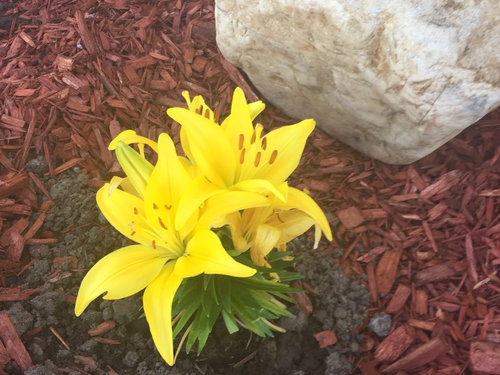Lilies are one of the most popular flowers in the world. They are also one of the most fragile. If you’re a lily lover, you know the heartbreak of watching your beautiful blooms wilt and die.
Why does this happen? There are a few reasons why your lilies might not be thriving.
If your lilies are dying, it could be for a number of reasons. Maybe the roots are rotten, or the bulbs have been damaged. It could also be that the plant is not getting enough water or nutrients.
How to deadhead your lilies
Why are My Outdoor Lilies Dying
Lilies are one of the most popular flowers in the world. They are also one of the most finicky. If you’re having problems with your outdoor lilies dying, there are a few things that could be causing it.
One of the most common reasons for lilies dying is because they aren’t getting enough water. Lilies need to be kept moist at all times – especially during hot summer months. If you live in an area with little rainfall, make sure to water your lilies regularly.
Another thing to keep in mind is that lilies don’t like soggy soil, so make sure to drainage is good and that the roots aren’t sitting in water.
If you think your lilies might be getting too much sun, try moving them to a shadier spot. Lilies prefer filtered sunlight and will often wilt and die if they are in direct sunlight for too long.
Fungal diseases can also cause lily death. The two most common fungal diseases affecting lilies are botrytis (gray mold) and fusarium (red-brown patches on leaves). Both of these diseases thrive in humid conditions, so keeping your lily beds well-drained is important.
You can also treat these diseases with fungicide, but it’s best to prevent them in the first place by keeping your plants healthy and free from stressors like drought or excessive heat/cold exposure.
Why are My Lilies Leaves Turning Yellow
Lilies are a beautiful and popular flower, but sometimes their leaves can turn yellow. There are a few reasons why this may happen.
One reason is that the plant is not getting enough water.
Lilies need to be kept moist, so if you see the leaves turning yellow, make sure to give them a good watering.
Another reason for yellowing leaves could be too much sun exposure. Lilies like bright light but not direct sunlight, so if they are in an area that gets too much sun, the leaves will start to turn yellow.
Move them to a shadier spot and see if that helps.
Yellowing leaves can also be a sign of nutrient deficiency. Make sure you are fertilizing your lilies regularly with a good quality fertilizer made specifically for them.
If you think they might be lacking in something else, consult with a local nursery or expert to find out what they recommend.
Finally, sometimes lilies just naturally go through cycles of yellowing and greening as they grow and mature. If the plant looks otherwise healthy and is blooming well, then this is probably nothing to worry about.
Just enjoy your beautiful lily!
How to Save Dying Lilies
Lilies are one of the most popular flowers in the world, beloved for their beauty and grace. But even these stunning blooms can succumb to disease and pests. If your lilies are looking sad and wilted, don’t despair – there are a few things you can do to revive them.
First, check for signs of pests or disease. Aphids, spider mites, and thrips are all common culprits that can suck the life out of lilies. If you see any bugs on the plants, gently remove them with a cotton swab dipped in rubbing alcohol.
For fungal diseases like botrytis or powdery mildew, try spraying the affected areas with a fungicide.
If your lilies seem healthy but are still wilting, they may be suffering from dehydration. Water them deeply, making sure to soak the roots thoroughly.
You can also try misting the leaves with water to raise humidity levels around the plant. Just be sure not to overwater, as this can lead to root rot.
Finally, give your lilies some extra TLC by fertilizing them regularly during active growth periods.
A good quality fertilizer will help keep them looking lush and vibrant all season long!
Why are My Asiatic Lilies Dying
If you’re wondering why your Asiatic lilies are dying, there are a few possible reasons. One possibility is that they’re not getting enough water. Lilies need about 1 inch of water per week, so make sure you’re watering them regularly and deeply.
You may also need to adjust your watering schedule depending on the weather; during hot, dry periods, you may need to water more frequently.
Another reason your lilies might be dying is because they’re not getting enough sunlight. Lilies need at least 6 hours of direct sunlight each day in order to thrive.
If your lilies are planted in an area that doesn’t get much sun, consider moving them to a sunnier spot.
Finally, Asiatic lilies can be susceptible to various pests and diseases. If you see any signs of pests or disease on your plants (e.g., wilting leaves, discoloration, etc.), take action immediately to treat the problem.
By taking good care of your Asiatic lilies and addressing any problems promptly, you can keep them healthy and beautiful for many years to come!

Credit: www.houzz.com
How Do You Revive a Dying Lily?
If your lily is looking limp and lifeless, there are a few things you can do to revive it. Start by checking the soil. Lily plants like their roots to be moist, but not wet, so make sure the soil isn’t soggy.
If it is, remove the plant from the pot and replant it in fresh, well-draining potting mix. Next, check for pests. Lily plants are susceptible to aphids and other pests that can suck the life out of them.
If you see any pests on your plant, treat them accordingly. Finally, give your lily some love. Cut back any dead or dying leaves and stems and fertilize with a high-phosphorus fertilizer formulated for bulbs.
With a little TLC, your lily should be back to its beautiful self in no time!
Do Lilies Come Back to Life?
There are many flowers that have a long and storied history, but few are as iconic and well-loved as the lily. These beautiful blooms have been celebrated in art and literature for centuries, and their elegant shape and vibrant colors have made them a favorite of gardeners around the world. But what about their ability to come back to life?
Do lilies really have this power, or is it just a myth?
The answer, it turns out, is a little bit of both. While there are certainly some species of lily that can regenerate after being cut down or even dried out, others will not survive if they do not receive the proper care.
In general, however, most lilies will not come back to life if they are not properly taken care of.
If you want to try your hand at reviving a Lily, there are a few things you need to keep in mind. First of all, make sure that the plant is completely dead before you attempt any sort of resuscitation – otherwise you may just end up damaging it further.
Once you’re sure it’s truly dead, trim off any brown or wilted leaves and stems until you’re left with only healthy tissue.
Next, soak the Lily in water for 24 hours before replanting it in fresh soil. This will give the plant time to absorb moisture and start growing again.
Be sure to keep an eye on it during this process – if the water becomes cloudy or discolored, discard it and start over with fresh water.
With some patience (and a little luck), your Lily should start showing signs of new growth within a few weeks time!
Why are the Leaves Falling off My Lillies?
If the leaves on your lilies are falling off, it’s likely due to a problem with the roots. Lilies are very susceptible to root rot, which is caused by too much water and not enough drainage. The first step in fixing this problem is to make sure that the lily bulbs are planted in well-drained soil.
If the bulbs are sitting in water, they will need to be replanted in a drier location.
Once you’ve made sure that the bulbs are properly planted, you can try watering them less frequently. Watering once a week should be sufficient, and making sure that the soil drains well after each watering will help prevent root rot.
If the leaves continue to fall off, you may need to treat the plants with an fungicide designed for root rot.
Are the Reasons for Calla Lillies Dying the Same as Other Lillies?
Calla lilies wilting usually indicates underlying issues, but these reasons may differ from other lilies. Common culprits include overwatering, underwatering, improper lighting, or extreme temperatures. However, it’s important to consult specific care guidelines for different lily varieties to ascertain the exact causes behind their wilting.
Why are the Bottom Leaves on My Lilies Turning Brown?
If the bottom leaves on your lily plant are turning brown, it is likely due to a lack of water. The leaves may be getting too much sun or heat, which can also cause them to turn brown. If you suspect that your plant is not getting enough water, try increasing the frequency of watering or moving the plant to a shady area.
If the leaves are still turning brown after you have adjusted the watering schedule, it is possible that the root system is damaged and needs to be replanted.
Conclusion
If you’re wondering why your lillies are dying, there could be a few reasons. It could be because of the type of soil they’re in, or it could be because of how much water they’re getting. Sometimes, lillies just don’t do well in certain climates.
If you think it might be one of these things, try changing up your lily care routine and see if that makes a difference.






